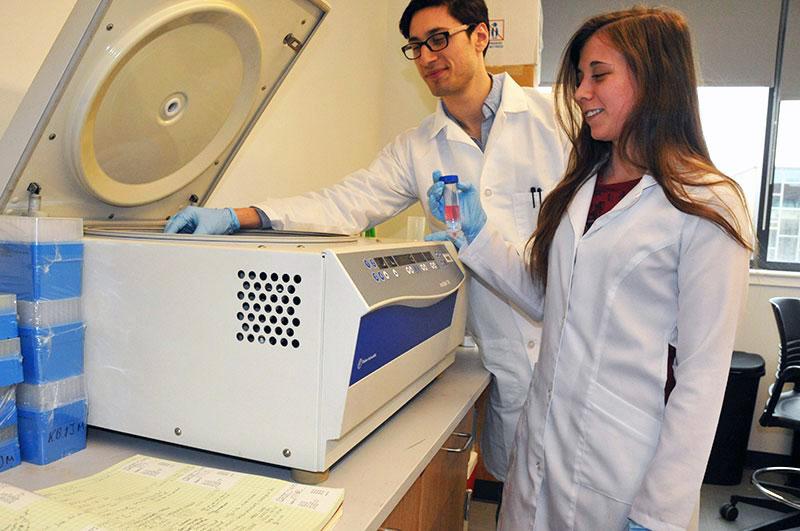Research experience—SUNY Oswego undergraduate biochemistry majors Iain Thompson (left) and Tatiana Gregory work on separating peripheral blood mononuclear cells from human blood samples. They are mentored by chemistry faculty member Kestas Bendinskas on a portion of a grant commissioned by Project: Time Off to explore physiological, as well as psychological, effects of paid vacations versus abstaining from vacation time.
SUNY Oswego chemistry professor Dr. Kestas Bendinskas and his student researchers recently shared in a grant for a preliminary study of stress markers and related effects among workers who take paid vacation time and those who leave some or all of it on the table.
Bendinskas received a share of a grant that Project: Time Off made to Syracuse University’s Dr. Brooks Gump and University of California, Irvine’s Dr. Sarah Pressman.
The money for Oswego supports hiring, training and mentoring student researchers to test blood samples drawn in Gump’s lab at Syracuse’s Falk College of Sport and Human Dynamics. It is the latest of several collaborations over the past decade Bendinskas has forged with Gump, a former Oswego psychology faculty member, that provide hands-on research experience for undergraduates.
The research, titled “The Psychological and Physiological Effects of Paid Vacations,” studies potential links of acute and chronic health issues in adult full-time employees who take, or refrain from taking, paid vacation time.
Project: Time Off, a coalition seeking to shift culture to make personal time considered less frivolous, has commissioned research studies in an effort to support and promote positive effects of taking paid time off. It has cited research from Oxford Economics that found Americans stockpiled 429 million days of earned leave last year—just over three days per worker—costing the U.S. economy $160 billion.
Bendinskas, who teaches biochemistry and has mentored many students in research projects, said that, through one’s personal experience, it might seem evident that time off produces beneficial psychological and physical effects. There is, though, a lack of peer-reviewed research about stress markers in the populations of vacationers and non-vacationers, he said. The researcher emphasized, “Our publications are not controlled or edited in any way by the funding agency. Whatever comes out of the study comes out.”
Honing skills
Gump, who is Falk Family Endowed Professor of Public Health at Syracuse, and Pressman, an associate professor of psychology at University of California, Irvine, also shared the blood and hair analytical work on the grant with Columbia University and University of California, San Francisco.
As in past studies involving large numbers of samples, Bendinskas recruits and trains students—there are funds to employ four this summer—to assist in the testing. Two of his assistants this semester are Iain Thompson, a senior biochemistry major who recently won a SUNY Chancellor’s Award for Student Excellence, and junior biochemistry major Tatiana Gregory.
Thompson said he is applying for research positions and eventually aims for medical school. Working with Bendinskas has made a “pretty profound” impact on his research skills, he said, including experience in PBMC (peripheral blood mononuclear cell) purification.
“One medical school I’m looking at is doing PBMC work,” he said. “We follow standards worldwide for storage, handling, testing and analysis of human blood samples.”
Gregory, who would like to attend D.O. (osteopathic) school, described such procedures as moving some human samples from the dry ice in which they are shipped to a laboratory freezer at -80 degrees; other samples must be kept at room temperature.
“There’s quite a bit of mentorship that goes into this. We’re working with human samples,” she said.
Bendinskas has co-authored six journal articles in the last 10 years with Gump.
“We have been very fortunate that Dr. Gump relies on his collaboration with Oswego biological sciences chair Dr. (James) MacKenzie for physiology and on me for biochemistry,” Bendinskas said.




